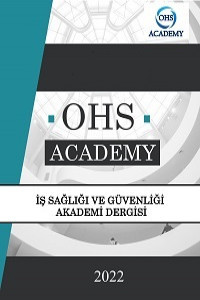Alabalık Yetiştiricilik Tesislerinde İş Sağlığı ve Güvenliği Risk Analizi
Alternatif gıda arzına cevap veren su ürünleri sektörü her geçen gün katlanarak büyümeye devam etmekte-dir. Bu nedenle su ürünleri yetiştiricilik tesislerinde artan iş yükünü karşılayacak insan gücüne ihtiyaç vardır. Her sektörde olduğu gibi su ürünleri yetiştiriciliğinde de çalışanlar için iş sağlığı ve güvenliği olduk-ça önemlidir. Mevcut çalışma, entegre bir alabalık yetiştirme tesisinde meydana gelebilecek vaka senaryo-larına odaklanmıştır. Bu kapsamda toplam 79 farklı vaka senaryosu için uzman görüşleri değerlendirilmiş-tir. 5x5 matris yöntemi ile analiz edilen vaka senaryoları, tesis genelinde, kültür tanklarında, tuvaletlerde ve yem depolarında yüksek riskli vakaların oluşabileceğini göstermiştir. Tüm vaka senaryolarında en fazla risk sayısı orta risk kategorisinde gözlenmiştir. Orta risk kategorisinde, özellikle tesis için öngörülen vaka senaryolarının gerçekleşmesi durumunda çalışanların ölüm ve uzuv kaybı gibi sonuçlarla karşılaşma olası-lığı bulunmaktadır. Proseslere göre 4 kümede toplanan vaka senaryoları için en düşük risk ortalamaları yemekhane ve soyunma odalarıdır.
Anahtar Kelimeler:
alabalık çiftliği, iş sağlığı ve güvenliği, risk değerlendirmesi, su ürünleri yetiştiriciliği
Occupational Health and Safety Risk Analysis in Trout Aquaculture Facility
The aquaculture sector, which responds to alternative food supply, continues to grow exponentially with each passing day. For this reason, there is a need for manpower to meet the increasing workload in aqua-culture facilities. As in every sector, occupational health and safety is quite important for employees in aquaculture. The current study focused on case scenarios that may occur in an integrated trout farming facility. Expert opinions for a total of 79 different case scenarios were evaluated. The case scenarios ana-lyzed with the 5x5 matrix method showed that high-risk cases can occur in the facility-wide, culture tanks, toilets and feed storage. The highest number of risks for all case scenarios is in the medium risk category. In the medium risk category, there is a potential for employees to encounter consequences such as death and loss of limbs, especially if the case scenarios foreseen for the facility are realized. The lowest risk averages for case scenarios collected in 4 clusters according to processes are dining hall and locker rooms.
___
- Ahmed, N., Thompson, S., & Glaser, M. (2019). “Global Aquaculture Productivity, Environmental Sustainabil-ity, and Climate Change Adaptability”. Environmental Management, 63(2), 159–172. https://doi.org/10.1007/s00267-018-1117-3
- Aydoğan, Ö. (2020). “Su Ürünleri Sektöründe Karşılaşılan İş Hastalıkları ve Meslek Hastalıkları Occupational Diseases Encountered in Fishery Sector”. Karaelmas Journal of Occupational Health and Safety, 4(1), 55–64. https://doi.org/10.33720/kisgd.558324
- Cavalli, L. S., Marques, F. B., & Watterson, A. (2020). “A critical overview of work-related injury and illness in aquaculture workers from Brazil”. Reviews in Aquaculture, 12(2), 1157–1164. https://doi.org/10.1111/raq.12377
- Cole, D. W., Cole, R., Gaydos, S. J., Gray, J., Hyland, G., Jacques, M. L., Powell-Dunford, N., Sawhney, C., & Au, W. W. (2009). “Aquaculture: Environmental, toxicological, and health issues”. International Journal of Hygiene and Environmental Health, 212(4), 369–377. https://doi.org/10.1016/j.ijheh.2008.08.003
- FAO. (2018). “The State of World Fisheries and Aquaculture: Meeting the Sustainable Development Goals”. www.fao.org/publications
- FAO. (2020). “The State of World Fisheries and Aquaculture 2020. Sustainability in action”. https://doi.org/10.4060/ca9229en
- Güner, E. D. (2018). “Environmental risk assessment for biological wastewater treatment plant”, Pamukkale University Journal of Engineering Sciences, 24(3), 476–480. https://doi.org/10.5505/pajes.2017.16023
- Gutierrez-Wing, M. T., & Malone, R. F. (2006). “Biological filters in aquaculture: Trends and research directions for freshwater and marine applications”, Aquacultural Engineering, 34(3), 163–171. https://doi.org/10.1016/j.aquaeng.2005.08.003
- Kılkıs, I. (2013). “İş Sağlığı ve Güvenliği’nde Yeni Dönem: 6331 Sayılı İş Sağlığı ve Güvenliği Kanunu (İSGK)”, “İş,Güç” Endüstri İlişkileri ve İnsan Kaynakları Dergisi, 15(1), 17–41. https://doi.org/10.4026/1303-2860.2013.0217.x
- Marques, F. B., Bettoni, G. N., Santos, B. G. T., Adeoye, A. A., Brito, B. G., Brito, K. C. T., Buketov, K., Cazella, S., Fermino, M. H., Hellebrandt, L., Jeebhay, M., Mitchell, R., Ngajilo, D., Watterson, A., & Cavalli, L. S. (2020). “AquaSafe: Aquaculture occupational safety and health in the palm of your hand”, Pesquisa Agropecuária Gaúcha, 26(1), 46–54. https://doi.org/10.36812/pag.202026146-54
- Matos, J., Costa, S., Rodrigues, A., Pereira, R., & Sousa Pinto, I. (2006). “Experimental integrated aquaculture of fish and red seaweeds in Northern Portugal”, Aquaculture, 252(1), 31–42. https://doi.org/10.1016/j.aquaculture.2005.11.047
- McGuinness, E., Aasjord, H. L., Utne, I. B., & Holmen, I. M. (2013). “Fatalities in the Norwegian fishing fleet 1990-2011”, Safety Science, 57, 335–351. https://doi.org/10.1016/j.ssci.2013.03.009
- Mert, B., & Ercan, P. (2014). “Su Ürünleri Sektöründe İş Sağlığı ve Güvenliği Uygulamalarının Değerlendirilme-si”, TUBAV Bilim Dergisi, 7(4), 16–27. https://dergipark.org.tr/tr/download/article-file/200983
- Moreau, D. T. R., & Neis, B. (2009). “Occupational health and safety hazards in Atlantic Canadian aquacul-ture: Laying the groundwork for prevention”, Marine Policy, 33(2), 401–411. https://doi.org/10.1016/j.marpol.2008.09.001
- Myers, M.L. (2011), Reducing Hazards in the Work Environment. In R. Friis & C. Friis (Eds.), The Praeger Handbook of Environmental Health. Praeger. https://products.abc-clio.com/abc-cliocorporate/product.aspx?pc=A3038C
- Myers, Melvin L., & Durborow, R. M. (2012), Aquacultural Safety and Health. In E. Carvalho (Ed.), Health and Environment in Aquaculture (pp. 385–400). InTech. https://doi.org/10.5772/29258
- Ngajilo, D., & Jeebhay, M. F. (2019). “Occupational injuries and diseases in aquaculture – A review of litera-ture”, Aquaculture, 507, 40–55. https://doi.org/10.1016/j.aquaculture.2019.03.053
- Özgür, C. (2021). “Dezenfeksiyon ünitesi risk analizi: içme suyu arıtma tesisi”, Ömer Halisdemir Üniversitesi Mühendislik Bilimleri Dergisi, 10(1), 16–22. https://doi.org/10.28948/ngumuh.741014
- Tadesse, T., & Admassu, M. (2006). Occupational Health and Safety (No. 663-A-00-00-0358–00). https://www.cartercenter.org/resources/pdfs/health/ephti/library/lecture_notes/env_occupational_health_students/ln_occ_health_safety_final.pdf (Erişim Tarihi: 04.07.2021)
- Valderrama, D., Hishamunda, N., & Zhou, X. (2010). “Estimating Employment in World Aquaculture”, FAO Aquaculture Newsletter, 24–25. http://www.fao.org/3/al363e/al363e.pdf (Erişim Tarihi: 05.06.2021)
- Waite, R., Beveridge, M., Brummett, R., Castine, S., Chaiyawannakarn, N., Kaushik, S., Mungkung, R., Na-wapakpilai, S., & Phillips, M. (2014). “Improving Productivity and Environmental Performance of Aquacul-ture”. https://digitalarchive.worldfishcenter.org/handle/20.500.12348/38 (Erişim Tarihi: 02.06.2021)
- World Bank. (2013). Fish to 2030: Prospects for Fisheries and Aquaculture. https://documents1.worldbank.org/curated/en/458631468152376668/pdf/831770WP0P11260ES003000Fish0to02030.pdf (Erişim Tarihi: 02.06.2021)
- Yayın Aralığı: Yılda 3 Sayı
- Başlangıç: 2017
- Yayıncı: Rüştü UÇAN
Sayıdaki Diğer Makaleler
İş Sağlığı Ve Güvenliği Yönetim Uygulamalarının Çalışanların İş Tatmini Üzerine Etkisi
Safiye Nazmiye ÖZTÜRK, Tülay ÖZTÜRK
Alabalık Yetiştiricilik Tesislerinde İş Sağlığı ve Güvenliği Risk Analizi
Mert MİNAZ, Kübra AK, İlker Zeki KURTOĞLU
Bazı Balıkçı Teknelerinde İş Sağlığı ve Güvenliği
Hüseyin Gökhan AYTEPE, Orkun DALYAN, Hatice DALYAN, Mehmet PİŞKİN
İstanbul'daki İtfaiyecilerde Travma Sonrası Stres Belirtilerinin İncelenmesi
